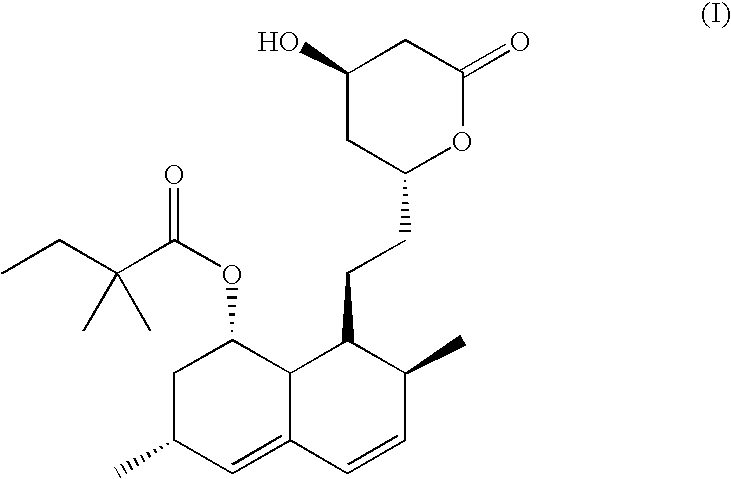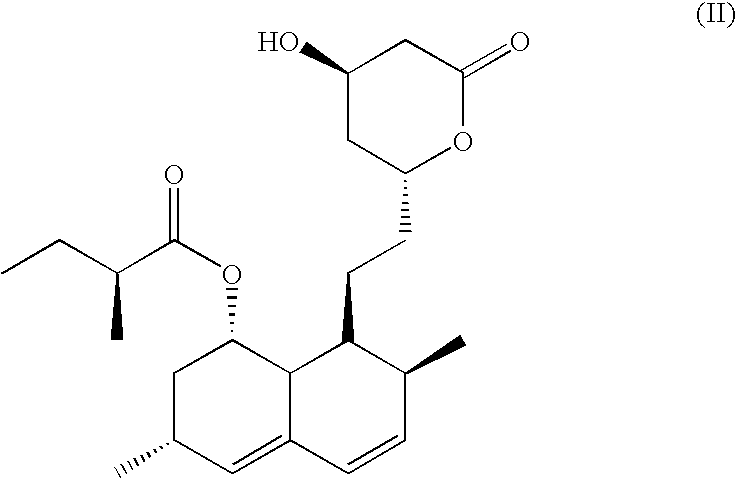Process for the preparation of simvastatin
a technology of simvastatin and process, which is applied in the field of process for the preparation of simvastatin, can solve the problems of low yield and purity of the final product, the c-methylation step must be carried out, and the difficulty of mass production, etc., and achieves the effect of high yield
- Summary
- Abstract
- Description
- Claims
- Application Information
AI Technical Summary
Benefits of technology
Problems solved by technology
Method used
Image
Examples
example
Example 1
Preparation of 7-[1′,2′,6′,7′,8′,8a′(R)-hexahydro-2′(S),6′(R)-dimethyl-8′(S)-hydroxy-1′(S)-naphthyl]-3(R),5(R)-dihydroxy heptanoic acid (the compound of formula (III))
140 g of potassium hydroxide was dissolved in 100 ml of water, and 600 ml of methanol was added slowly thereto while keeping the temperature at 20° C. using an ice bath, followed by adding 100 g of lovastatin thereto at 20° C. The mixture was refluxed using an oil bath for 8 hours, and 150 ml of water was added thereto. Subsequently, methanol was removed under a reduced pressure, and 550 ml of water and 300 ml of diethylether were added thereto. The mixture was acidified by slowly adding 6N—HCl at 5 to 10° C. with stirring, and stirred for additional 30 minutes at the same temperature. The resulting precipitates were filtered, washed with a mixture of water and diethylether, and dried, to obtain 82 g of the title compound as a white solid(yield: 98%, purity: 98.6%).
m.p.: 128° C.
1H-NMR(δ, CDCl3): 5.98(d, ...
example 2
Preparation of 6(R)-[2-(8′(S)-hydroxy-2′(S),6′(R)-dimethyl-1′,2′,6′,7′,8′,8a′(R)-hexahydronaphthyl-1′(S))ethyl]-4(R)-hydroxy-3,4,5,6-tetrahydro-2H-pyran-2-one(the compound of formula (IV))
79 g of 7-[1′,2′,6′,7′,8′,8a′(R)-hexahydro-2′(S),6′(R)-dimethyl-8′(S)-hydroxy-1′(S)-naphthyl]-3(R),5(R)-dihydroxy heptanoic acid prepared in Example 1 was dissolved in 560 ml of ethyl acetate, and 0.8 g of p-toluene sulfonic acid was added thereto. The reaction mixture was stirred at room temperature for 3 hours, followed by addition of 700 ml of hexane, and stirred for additional 30 minutes. The resulting precipitates were then filtered, washed with 100 ml of hexane, and dried, to obtain 73.5 g of the title compound as a white solid(yield: 98%, purity: 98.2%).
m.p.: 125-126° C.
1H-NMR(δ, CDCl3): 6.0(d, 1H), 5.80(dd, 1H), 5.54(bs, 1H), 4.72(m, 1H), 4.38(m, 1H), 4.23(bs, 1H), 2.68(dd, 2H), 2.39(m, 2H), 2.15-1.78(m, 9H), 1.58-1.18(m, 4H), 1.19(d, 3H), 0.90(m, 1H)
example 3
Preparation of 6(R)-[2-(8′(S)-hydroxy-2′(S),6′(R)-dimethyl-1′,2′,6′,7′,8′,8a′(R)-hexahydronaphthyl-1′(S))ethyl]4(R)-(dimethyl-tert-butyl silyloxy)-3,4,5,6-tetrahydro-2H-pyran-2-one (the compound of formula (V))
70 g of 6(R)-[2-(8′(S)-hydroxy-2′(S),6′(R)-dimethyl-1′,2′,6′,7′,8′,8a′ (R)-hexahydronaphthyl-1′(S))ethyl]4(R)-hydroxy-3,4,5,6-tetrahydro-2H-pyran-2-one prepared in Example 2 was dissolved in 800 ml of dichloromethane, and 43 g of imidazole and 43 g of t-butyl dimethylchlorosilane were successively added thereto. The reaction mixture was stirred at 25 to 30° C. for 6 hours, and washed successively three times with 300 ml of water, 200 ml of 0.2 N—HCl, 100 ml of saturated sodium bicarbonate and 100 ml of saturated saline. The organic layer was then separated, dried over anhydrous MgSO4, filtered and the solvent was removed. 300 ml of hexane was added to the resulting solid, and stirred at room temperature for 30 minutes. The resulting precipitates were filtered, and dried, to ...
PUM
| Property | Measurement | Unit |
|---|---|---|
| temperatures | aaaaa | aaaaa |
| temperature | aaaaa | aaaaa |
| temperature | aaaaa | aaaaa |
Abstract
Description
Claims
Application Information
 Login to View More
Login to View More - R&D
- Intellectual Property
- Life Sciences
- Materials
- Tech Scout
- Unparalleled Data Quality
- Higher Quality Content
- 60% Fewer Hallucinations
Browse by: Latest US Patents, China's latest patents, Technical Efficacy Thesaurus, Application Domain, Technology Topic, Popular Technical Reports.
© 2025 PatSnap. All rights reserved.Legal|Privacy policy|Modern Slavery Act Transparency Statement|Sitemap|About US| Contact US: help@patsnap.com



